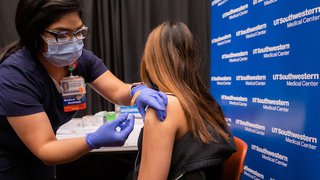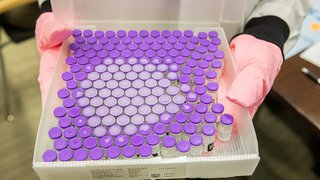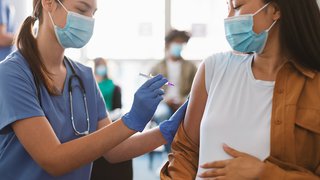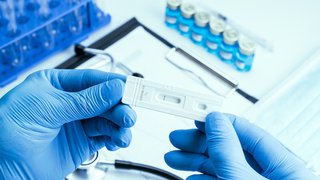
For the first year of the COVID-19 pandemic, there was one big question hovering over nearly every conversation: “When will a vaccine be ready?”
Now that three vaccines have been authorized by the Food and Drug Administration (FDA) for emergency use and all are widely available to the general public, the topics of conversation have shifted to:
- How safe and effective are the vaccines?
- What, if any, side effects do they cause?
- And do I really need the shot to be protected from COVID-19?
UT Southwestern’s epidemiologists and infectious disease specialists have reviewed the safety data for the COVID-19 vaccines and concluded that all three (manufactured by Pfizer/BioNTech, Moderna, and Johnson & Johnson) are safe and effective. UT Southwestern, along with the CDC and FDA, recommends that eligible patients (ages 12 and up) get vaccinated against COVID-19 to protect themselves, their families, and the community.
But we know there are still some questions about the vaccines, as well as a blizzard of misinformation on social media about their safety. So here are evidence-based answers about the COVID-19 vaccines from a medical professional who was among the first in line to take one.
This article, originally published on Dec. 11, 2020, was updated on May 19, 2021.
1. What’s in the vaccines and how do they work?
The FDA has authorized for emergency use vaccines created by Pfizer/BioNTech, Moderna, and Johnson & Johnson. The Pfizer and Moderna vaccines use what’s called messenger RNA (mRNA), which in this case is a synthetic material that carries the genetic code used to make the SARS-CoV-2 spike protein. The spike is the part of the virus that attaches to human cells. The mRNA is showing your immune system a part of the virus, so that when your body encounters the whole virus in real-life, it recognizes the invader and is able to mount a quick immune response, activating antibodies (B and T-cells) to fight it.
Vaccines using mRNA are new but the technology has been around for decades and has been used in treatments for other diseases such as cancer and cystic fibrosis. While many vaccines use a weakened or inactive version of the virus to create an immune response, these vaccines don’t so there is no risk of their causing disease.
The J&J vaccine is an adenoviral vector vaccine, which means it contains an engineered virus that can't cause disease. Within that virus is the genetic code for the SARS-CoV-2 spike protein. After the shot, the adenovirus enters the cells and then shows that spike protein to your immune system so that if you encounter the whole virus in real-life, your body can mount a quick and effective response to fight it.
On April 13, distribution of the J&J vaccine for COVID-19 was paused by the FDA while it conducted an investigation into reports of rare blood clots in a few patients shortly after receiving that vaccine. On April 23, J&J vaccinations resumed following an extensive safety review by the CDC and FDA, which determined the benefits of the single-shot J&J vaccine outweigh the exceptionally rare risk of blood clots. An independent panel of experts reiterated the vaccine meets the FDA’s standards for safety and effectiveness while also making sure that more information about the possible side effect is available to the public.https://www.cdc.gov/coronavirus/2019-ncov/vaccines/different-vaccines/overview-covid-19-vaccines.html
2. How effective are the vaccines?
In phase three clinical trials involving thousands of people, all three vaccines were completely effective in preventing serious COVID-19 illness, hospitalizations, and deaths. They were also well above the 50% efficacy rate necessary to receive emergency use authorization from the FDA.
The Pfizer and Moderna vaccines were nearly 95% effective in preventing symptomatic COVID-19 in clinical trials and 100 % effective in preventing hospitalization and death. This is about as good as it gets, according to the nation’s top infectious disease experts, including Dr. Trish Perl, Chief of UT Southwestern’s Infectious Diseases Division. The single-shot J&J vaccine was 67% effective in preventing all COVID-19 illness in clinical trials. It was 85% effective in preventing severe illness, and 100% effective in preventing hospitalizations and deaths.
Since being authorized by the FDA, all three vaccines have proven themselves highly effective in real-world conditions.
3. Will the vaccines protect against new strains of the virus?
UT Southwestern infectious diseases experts say there is no reason to think that mutations, particularly those first identified in the U.K., South Africa, and Brazil, will impact the effectiveness of the vaccines currently available. Thousands of mutations of the SARS-CoV-2 virus have been documented since the beginning of the pandemic. Only a few have warranted deeper studies. The U.K. variant appears to be about 40% more transmissible or contagious and could become the dominant virus lineage in the U.S. The emergence of new variants reinforces the importance of getting a COVID-19 vaccine when one becomes available to you. We also must continue to practice the safety measures that have successfully reduced the spread of COVID-19 thus far.
4. How do we know steps weren’t skipped to produce the vaccines faster?
There is a well-established testing and clinical trial regimen that must be followed for the FDA to consider approving a vaccine. For these COVID-19 vaccines, the research was performed concurrently, rather than consecutively, and the wait times for review of the research were substantially reduced through Operation Warp Speed, a federal program that invested in development and manufacturing of the vaccines.
No steps were skipped, and safety was not sacrificed for speed.
An independent and transparent monitoring board of experts reviewed the trial data, and career scientists evaluated it at the FDA. All of the clinical trial information will be published in peer-reviewed journals.
5. Why do some vaccines require two shots, and what if you miss the second shot?
The Pfizer and Moderna vaccines each require two shots (21 days apart for Pfizer; 28 for Moderna). The first dose triggers the immune response, and the second one, often called a “booster,” primes the body to memorize the virus so it will recognize it immediately in the future and fight it off. Many vaccines require boosters, such as tetanus, shingles, and MMR.
If you skip the second shot it’s less likely you’ll develop full immunity, not to mention wasting a valuable dose of vaccine. Health care providers will try to make it as convenient as possible to set up both appointments at the same time and will provide reminders to get the second shot.
The J&J vaccine only requires one shot.
6. Do the vaccines have any serious side effects?
Some trial participants experienced arm soreness, fatigue, chills, fever, or headaches that lasted a day or two, most often after the second shot. But that reaction is typically a sign that the vaccine is working – triggering the immune response (or inflammation) indicating your body recognizes this never-before-seen pathogen and is mounting a protective response against it.
The clinical trials will continue to monitor patients for side effects long after patients are vaccinated. The state of Texas will use the Vaccine Adverse Event Reporting System (VAERS), a national system co-managed by the Centers for Disease Control (CDC) and FDA, to track vaccine safety and side effects. Texas will also employ an app called v-safe, which sends vaccine recipients text messages and check-in emails to keep tabs on their health, as well as remind them when it’s time to get their second shot.
7. Do the vaccines present any long-term health risks?
Phase 3 vaccine trial participants were monitored for 60 days after receiving their second shot, which is required before any safety data can be submitted to the FDA. Typically, if a patient hasn’t experienced severe side effects in 60 days, it is extremely unlikely they will. But because these vaccines are so new, significant long-term data are still being collected.
According to clinical trial safety documents released by the FDA on Dec. 7, there were four cases of Bell's palsy, a condition that temporarily weakens the facial muscles, among Pfizer clinical trial participants who received the vaccine. The rates of Bell’s palsy, however, were no different than what occurs in the general population and there is no evidence the vaccine caused the problem.
The FDA, “out of an abundance of caution,” decided on April 13, 2021, to pause distribution of the J&J vaccine after a small number of women between the ages of 18 and 48 experienced blood clots within 13 days of vaccination.
Scientists at the FDA and CDC reviewed safety data and on April 23 recommended that J&J vaccinations resume, stating the vaccine’s known and potential benefits far outweigh its potential risks. Women younger than 50 should be aware of the rare but increased risk, the CDC said, and that there are other COVID-19 vaccine options available.
Vaccine |
Pfizer/BioNTech |
Moderna |
J&J |
|---|---|---|---|
Technology |
mRNA |
mRNA |
Viral vector |
Phase 3 trial participants |
44,000 |
30,000 |
43,000 |
Efficacy rate |
95% |
94.5% |
67% |
Doses needed |
2, 21 days apart |
2, 28 days apart |
1 shot |
Status |
Authorized 12/11/2020 |
Authorized 12/18/2020 |
Authorized 2/27/2021 |
Storage temperature |
-94 degrees Fahrenheit |
-4 degrees Fahrenheit |
-4 degrees Fahrenheit |
Immunity across different populations
8. How long does it take for immunity to develop after getting vaccinated?
The FDA documents said the Pfizer vaccine showed more than 50% immunity 10 days after the first shot, and 95% immunity seven days after the second shot.
The booster is necessary to strengthen the immune response and provide near full protection. Also, keep in mind that exposure is still possible between doses, so continue to wear a mask and follow hand-washing and physical distancing recommendations.
9. How long will immunity to COVID-19 last?
There’s no definitive way to tell yet, but some studies have indicated it could last years, even decades. The research showed that patients who contracted COVID-19 early in 2020 had robust antibodies six months later. Studies of survivors of SARS, also caused by a coronavirus, showed that participants carried immune cells 17 years after being infected. So there are some reasons to be encouraged, but scientists will need to continue monitoring the length and strength of immune responses in vaccinated patients.
10. Do the vaccines work in older and more vulnerable people?
The vaccines appear to maintain high efficacy rates regardless of age, sex, and ethnicity. For example, Pfizer’s vaccine was 94% effective in adults over age 65, according to safety data. All of the vaccines have also been tested in people with stable pre-existing conditions such as diabetes and cancer, and efficacy rates held at essentially the same levels.
11. Will the vaccines be safe for children and pregnant women?
The first clinical trials did not include children or expectant mothers, but Pfizer recently received authorization to vaccinate 12-15 year-olds after a study with more than 2,000 participants in that ages range showed vaccine to be 100 percent effective. Moderna began enrolling ages 12-17 in early December and results could be available very soon.
Early clinical trial data suggest that the COVID-19 vaccine are safe in pregnancy and breastfeeding, and may also benefit newborns.
Vaccines meant for adults and children are typically tested in adults first to ensure they’re safe before pediatric trials begin. Historically, pregnant women have not been included in vaccine trials, but there were a small number of women in the Pfizer clinical trial that became pregnant during the study, without any short-term complications.
12. When will children under 12 be eligible to be vaccinated?
Pfizer and Moderna have enrolled children as young as 6 months in clinical trials. Those results are pending and if the data show the vaccines are safe in this age group, the FDA will make vaccines available to younger children.
13. Will the vaccine affect fertility in women?
There is no evidence or reason to think COVID-19 vaccines affect fertility, despite some claims to the contrary circulating on the internet. Those reports are rooted in the theory that because the SARS-CoV-2 spike protein resembles the syncytin-1 protein, which is crucial for formation of the placenta, the COVID-19 vaccines might prompt an immune response that targets the placenta protein. But virologists say the two proteins are completely unrelated and not similar enough to confuse antibodies that attack the virus.
14. Do people who have recovered from COVID-19 need to get vaccinated?
It’s unclear how long natural immunity lasts after recovering from COVID-19, and there has been some data to suggest it begins to wane after 90 days. Similarly, the level of immunity you have after COVID-19 therapies such as convalescent plasma or monoclonal antibodies is unknown. There have been a few reported cases of re-infection, so the CDC advises people to get a vaccine even if they have been sick with COVID-19 before.
15. Why do some vaccines need to be stored in such cold temperatures?
Cold chain requirements vary and are based on the formulation of the vaccine. In some, such as the Pfizer vaccine (stored at -94 degrees Fahrenheit; think dry ice), the molecules become unstable and degrade if they are left out in warmer temperatures. Moderna’s vaccine needs to be stored at -4 degrees Fahrenheit, or about the temperature of a regular freezer.
With more study, it could become apparent that the vaccines don’t require such low temperatures, but they were developed and tested in a specific way during the clinical trials so that is the protocol to follow. Several other vaccines, such as the one from Johnson & Johnson, require only refrigeration.
16. Where will the vaccine be available?
At first, hospitals and health care facilities were the primary places to receive a vaccine. Some states set up immunization sites in the community. By May 2021, vaccines became widely available. You can get them at your doctor’s office or at most retail pharmacies. UT Southwestern continues to offer vaccinations to people ages 12 and up at multiple locations in Dallas. Please visit our COVID-19 website to schedule your vaccine.
17. How much will a vaccine cost?
Vaccines are free. They have already been paid for by the federal government with taxpayers’ money.
The Making of a COVID-19 Vaccine
See how the complex process works and how it has been accelerated to combat the pandemic.
Life after getting vaccinated
18. If I get the vaccine, does that mean I can’t get the disease?
The vaccines are very effective, according to safety data, but they’re not 100%. So it is still possible, but highly unlikely. If you were to become infected, the antibodies from the vaccine should shield you from developing COVID-19 symptoms or severe illness.
19. Will I still need to wear a mask and social distance after getting vaccinated?
On May 13, 2021, the CDC updated its guidance to say that fully vaccinated people no longer need to wear a mask or physically distance, except where required by laws or workplace guidance. That doesn't mean you should get rid of your mask. It is still recommended to wear one when on a plane, in an airport, and while on public transportation, for instance. Masks are still required in hospital and health care settings as well.
But fully vaccinated people – which means two weeks after your second shot if you've had Pfizer or Moderna, or 14 days after the J&J single-dose vaccine – are safe from serious illness from COVID-19 and can resume normal activities without wearing a mask.
Wearing a mask, washing hands regularly, and practicing physical distancing remain important safety measures for people who are not fully vaccinated. They are still at risk for COVID-19 infection and spreading the virus.
20. Do the benefits of getting the vaccine outweigh the risks?
Ultimately, this is the question you should ask yourself if you are unsure about whether to get vaccinated. But after evaluating the trial data and considering the documented record of vaccines in general, the answer is unequivocal: Yes, the benefits outweigh the risks.
Vaccinology is one of the safest interventions we have in patient care and disease prevention, and it has a long history of protecting the public – from smallpox to polio to measles. Yes, there are low-grade side effects, but they seem minor compared to the protections and freedom that safe and effective COVID-19 vaccines can provide.











